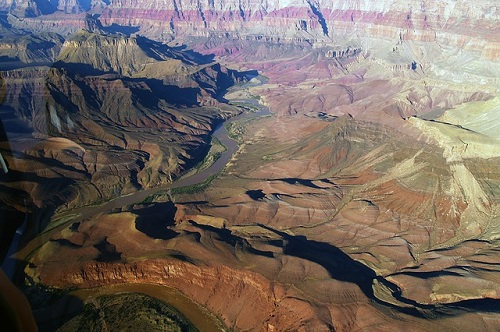Lassen Volcanic National Park is one of the oldest and most unique national parks in the United States, yet its remote location means it receives far fewer visitors than you would expect. In our Lassen Volcanic National Park guide, we aim to explain to people exactly what they are missing.
Beyond showing you the incredible attractions on offer in both the park and its surrounding areas, we will give you tips on things like the best time to visit, how long to stay for, the most convenient way to get there, and where to stay when you arrive.
So, if you have been thinking of taking a trip to Lassen Volcanic National Park but needed some more information, or even if we have just now piqued your interest, this article will give you all of the information you could possibly need to complete a dream vacation.
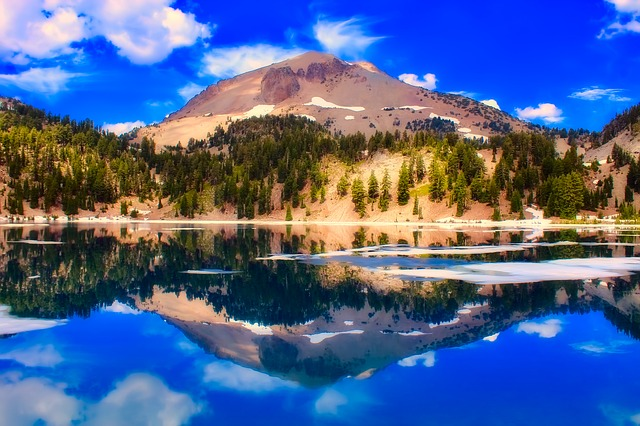
Facts & Figures About Lassen Volcanic National Park
Founded on the 9th of August 1916, Lassen Volcanic National Park is the 11th oldest national park in the United States. Originally established as two independent national monuments by President Theodore Roosevelt in 1907, they were combined due to the region’s prominent volcanic activity.
Covering a just under 106,600 acres, Lassen Volcanic ranks as only the 40th largest national park in the U.S., while its 360,000 annual visitors also make it the 43rd most visited.
Located in northern California, Lassen Volcanic National Park is best known for being one of the only places on Earth to feature all 4 types of Volcanoes.
Lassen Peak is the largest lava dome volcano on the planet but hasn’t erupted since 1915. However, many of the other volcanoes that surround it are constantly active. These fuel one of the largest collections of geothermal features in the country outside of Yellowstone National Park .
Both Lassen Volcanic National Park and the nearby Lassen National Forest are named after Peter Lassen, a rancher, miner, and prospector who lived in and heavily promoted the area to potential investors and emigrants in the mid-19th century.
Lassen Volcanic National Park Temperature
The Lassen Volcanic National Park Temperature usually ranges between a low of 20.2°F (-6.6°C) and a high of 79.1°F (26.2°C). The highest temperature ever recorded in the park is 97°F (36°C) and the lowest is -13°F (-25°C). Temperatures can vary wildly throughout the park though.
The highest temperatures in the park occur between the start of June and the end of September, while the coldest stretch is from late October to early May.
The park is reasonably dry in July and August, but experiences heavy precipitation the rest of the year. This includes heavy snowfall from late October to mid-May.
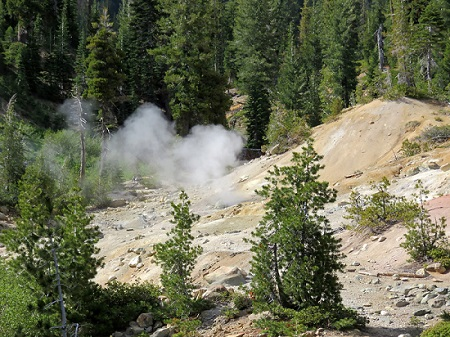
Best Time To Visit Lassen Volcanic National Park
The best time to visit Lassen Volcanic National Park is from the start of July to mid-August.
This period offers the perfect combination of the warmest, driest weather the park experiences all year, while avoiding the height of California wildfire season, which usually starts in late August.
This makes it the ideal time to ensure you can enjoy all Lassen Volcanic National Park has to offer, without having to worry about the weather or a natural disaster.
The Wildlife & Landscape Of Lassen Volcanic National Park
The landscape of Lassen Volcanic National Park is best known for its dramatic rock formations and being home to at least one of each of the four known types of volcanoes. These power geothermal features throughout the park, such as boiling mud pots, fumaroles, and hot springs.
The park also has a number of stunning creeks, lakes, rivers, and snowfields, surrounded by old growth conifer forests full of Jeffrey pines, lodgepole pines, mountain hemlocks, ponderosa pines, red firs, sugar pines, western white pines, whitebark pines, and white firs.
These are then complimented by a beautiful array of plants such as ceanothus, gooseberry, and manzanita bushes, as well as plants and flowers like Indian paintbrushes, iris’, lupins and lupines, penstemons, pyrolas, rock spireas, spotted coralroots, violets, and woolly mule’s ears.
Finally, you have the wildlife of Lassen Volcanic National Park. This includes an incredible array of species, such as black bears, bobcats, chipmunks, cougars, coyotes, martens, mountain chickadees, mice, mule deer, pikas, racoons, red foxes, salamanders, skunks, bats, squirrels, and weasels.
The red fox is of huge interest, as it is one of the rarest mammals in the state and the park is home to the largest population in the Sierra Nevada mountains. You will also find a range of different fish, as well as more than 220 species of birds, including brown creepers and white-headed woodpeckers.
How To Get To Lassen Volcanic National Park
The closest airport to Lassen Volcanic National Park is Reno/Tahoe International Airport in Reno, Nevada. It is 130 miles (210 km) away and takes 2 and ½ hours to reach by car.
Sacramento International Airport is then 155 miles (250 km) away, while the closest airport for international travellers is San Francisco International Airport, which is 250 miles (400 km) away. These take 3 hours and 4 hours to drive to, respectively.
Top Attractions In Lassen Volcanic National Park
As you should now have a better idea of what makes Lassen Volcanic National Park so special, it is time to move on to showing you what there is to do when you arrive.
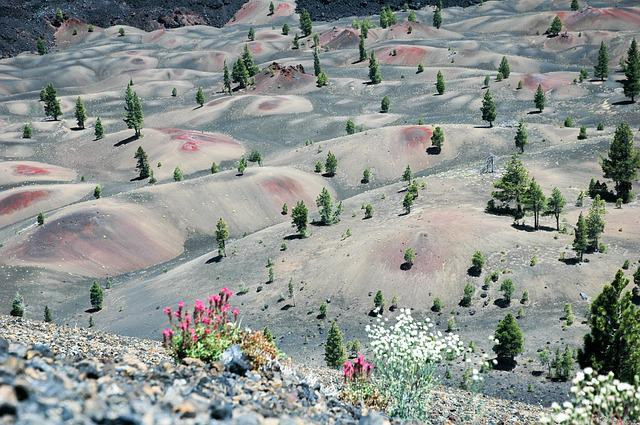
Our list of the top attractions in Lassen Volcanic National Park will help you to plan the perfect travel itinerary for your very own adventure into the California wilds.
Hike The Lassen Peak Trail
The Lassen Peak Trail is a 5 mile (8 km) hiking trail that leads to the top of Lassen Peak, the largest lava dome volcano on the planet. While the nearly 2,000 foot (600 metre) ascent to the top will take most people 4 to 5 hours to complete, it is more the worth the trouble.
From the peak you will be able to witness incredible views of not just the crater of Lassen Peak itself but also the entire Lassen Volcanic National Park landscape. This makes it the number one activity for anyone wanting to experience the true magnitude and beauty of the park.
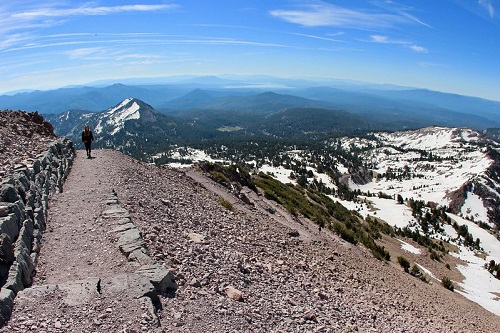
Marvel At The Geothermal Features
Due to the continuous volcanic activity in Lassen Volcanic National Park, it is home to a huge number of geothermal features and locations. This includes everything from fumaroles and hot springs to boiling mud pots.
While Little Hot Springs Valley and the Sulphur Works both give you the chance to see these features, the best place to see them is at Bumpass Hell, which is located on Bumpass Mountain.
Named after 19th century cowboy Kendall Bumpass who lost his leg after falling into one of the mud pots, the 16 acre geothermal area boasts examples of all of the features. This lets you see them all at once, while enjoying the stunning views that backdrop them.
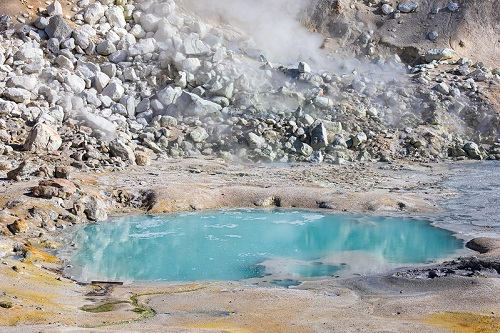
See The Difference Between The Four Different Types Of Volcanoes
As one of the only locations on earth to feature all four types of volcanoes, Lassen Volcanic National Park provides the perfect opportunity to see them all at the same time and compare the differences.
Lassen Peak is a lava dome (sometimes known as a plug dome) volcano, known for and named after its rounded, mound-like aesthetic. The highest point in the park, its peak sits 10,457 feet (3,187 metres) above sea level.
There is also a group of smaller lava dome volcanoes located in the park, known as the Chaos Crags.
You then have Mount Harkness, Prospect Peak, Raker Peak, and Red Mountain, all of which are shield volcanoes that peak between 7,000 and 8,400 feet (2,133 and 2,560) above sea level. Shield volcanoes are again circular but are much flatter than dome volcanoes and resemble a shield.
The park’s cinder cone volcano is simply known as Cinder Cone, and peaks at 6,896 feet (2,102 metres) above sea level. Cinder cones are known for their steep, conical shape and are perhaps the most iconic and well known type of volcano.
The final type of volcano, known as either a composite or stratovolcano, looks very similar to cinder cone volcanoes, yet is made up from layer upon layer of hard lava and tephra.
Lassen Volcanic’s example of a stratovolcano is Brokeoff Volcano. A remnant of the ancient Mount Tehama, the eruptions of which formed much of the park’s landscape, its peak sits at 9,239 feet (2,816 metres) above sea level, making it the 2nd highest point in the park.
With a collection like this, you can become a volcano expert in a single day or simply hike through the park, taking in its varied volcanic landscape.
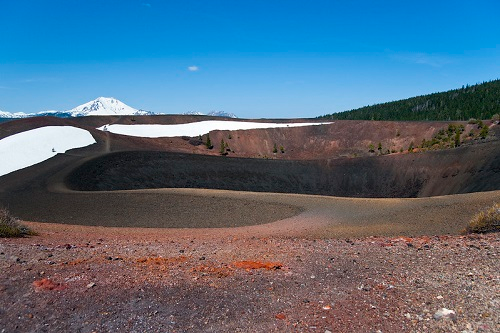
Appreciate The Beauty Of Lake Helen
Lake Helen is one of the highest, largest, and most iconic lakes in Lassen Volcanic National Park. It sits at 8,200 feet (2,500 metres) above sea level and is named after Helen Tanner Brodt, the first white woman to scale Lassen Peak, which is located just to the north of the lake.
Due to its high elevation, the lake is surrounded by ice and snow from late October to early August. When you combine the unique beauty of the lake with the stunning views of the surrounding area on offer, Lake Helen offers perhaps the best vistas you will find anywhere in the park.
Located along both the Bumpass Trail and California State Route 89, you can make the most of the views, no matter whether you want to drive or hike.

Spend Some Time In The Manzanita Lake Naturalist’s Services Historic District
The Manzanita Lake Naturalist’s Services Historic District covers the northwest corner of Lassen Volcanic National Park. Established in 1927, in includes most of the oldest structures in the area and was created by Benjamin and Estella Loomis, who pushed for the creation of the park.
It centres around Manzanita Lake, a stunning body of water filled with a variety of fish that is the largest lake in the park. This is then surrounded by buildings including Loomis House, Loomis Museum, and the Discovery Center.
Listed on the United States National Register Of Historic Places since 2006, there may not be a better place to appreciate the art, culture, history, and natural beauty of both Lassen Volcanic National Park and the surrounding region than right here.

Take A Trip To Kings Creek Falls
Kings Creek Falls is the most impressive waterfall in Lassen Volcanic National Park. Standing at roughly 40 feet (12 metres) tall, its cascading water provides a beautiful contrast to the rugged rock formations that dominate the park’s landscape.
With a 2.4 mile (3.9 km) loop trail circling it, you can take a leisurely hike to either the top or bottom of the falls to snap some photos or simply enjoy the sound and aesthetic of the flowing water. There is even a picnic area along the way where you can rest and refuel along the way if you need.
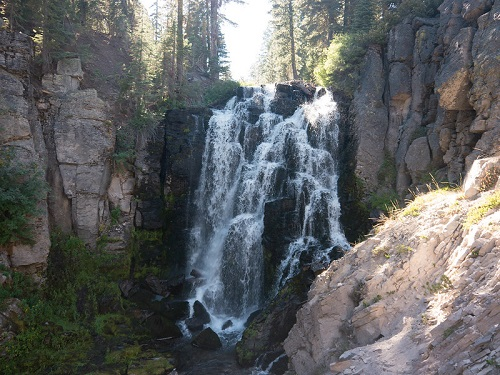
Things To See And Do Near Lassen Volcanic National Park
Despite being in a rural part of northern California, there are still a number of locations surrounding the park worth visiting as well.
With that in mind, we will now look at the best things to see and do near Lassen Volcanic National Park, to ensure your travel itinerary is as comprehensive as possible.
Lassen National Forest
Established in 1905 about the same time as the original Lassen Volcanic national monuments, Lassen National Forest covers just over 1 million acres that are filled with wilderness areas and old growth forests. It surrounds Lassen National Park on all sides.
While most of the wildlife in the forest is identical to that found in the park, one major difference is the presence of wolves. Having started to be reintroduced in 2011, Lassen National Forest is one of the only places they can be found in the state.
While the landscape is similar in some respects as well, there are much denser areas of forest here, as well as features such as caves. The Subway Cave lava tube is one of the most prominent attractions in the forest and stretches for 0.3 miles (0.5 km).
With various other culturally and historically significant sites doted throughout it, Lassen National Forest is more than worth visiting, despite its many similarities to Lassen Volcanic National Park.
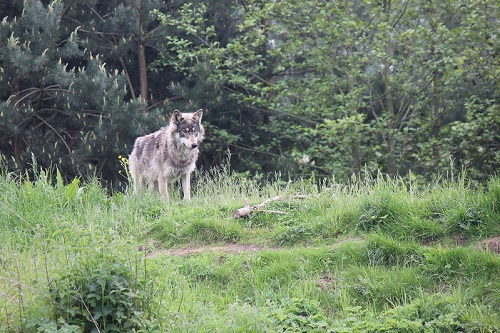
Redding, California
Redding was settled in the mid-19th century and was, at the time, the northernmost European settlement in the state. Located in the Shasta Cascade region, it remains the 2nd largest city north of Sacramento anywhere in California.
This is largely thanks to the diverse range of people that flocked to Redding from around the globe as it established itself as one of the hotspots of the California Gold Rush.
While its population and economy have both dropped since its peak, the impact of its varied inhabitants have still allowed it to retain a status as the economic and cultural centre of the region.
With both historic and natural attractions in abundance in and around Redding, such as the iconic Sundial Bridge, it is a fabulous yet often overlooked destination that is well worth visiting while you are in the area.
Read our guide to the best things to do in Redding, California, here.
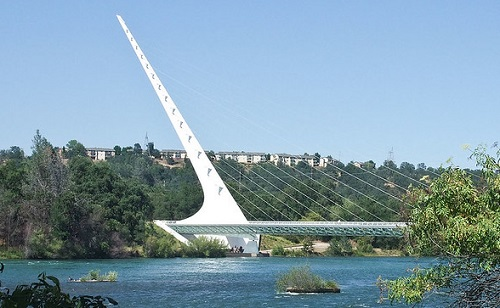
Shasta-Trinity National Forest
Shasta-Trinity National Forest is a pair of interconnected national forests that were both established in 1905, before being joined together in 1954. Covering more than 2.2 million acres between them, they constitute the 23rd largest national forest in the United States.
The most famous attractions in Shasta-Trinity are the eponymous, 30,000 acre Shasta Lake, the largest man-made lake in California, the 14,179 foot (4,322 metre) high Mount Shasta, and the 165 mile (266 kilometre) long Trinity River.
You then have a collection of other lakes, rivers, and peaks, as well as forests filled with wildlife, trails, byways, and wilderness areas, making it a hugely popular stop for activities like hiking, climbing, backpacking, and camping.
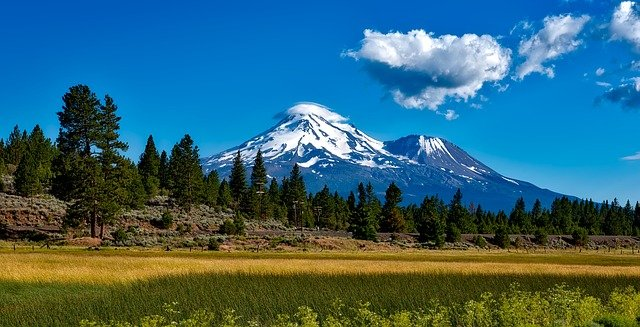
Best Place To Stay Near Lassen Volcanic National Park – Highlands Ranch Resort
The Highlands Ranch Resort is a fabulous establishment perfectly situated just a short way from the entrance to Lassen Volcanic National Park. Boasting a bar and restaurant, while also offering free parking, it is ideal when you want to rest up with some food or drink after a long day exploring.
The rooms themselves are then all spacious and feature comfortable furniture and linens, a large seating area with a flat screen satellite TV and coffee making facilities, and a private bathroom with a shower, hairdryer, and luxury towels. This ensures complete relaxation throughout your stay.
All rooms also come with a patio offering mountain views and a choice of American and a la carte breakfasts is offered each morning. Free Wi-Fi is available in all of the communal areas.
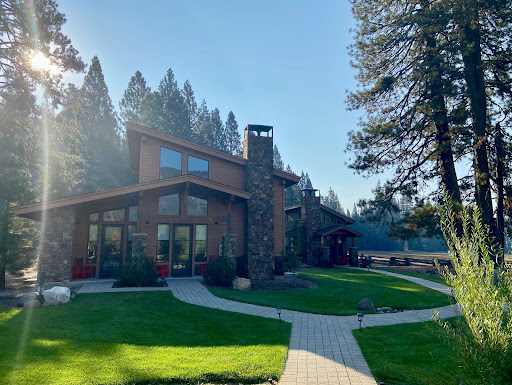
How Many Days To Spend In Lassen Volcanic National Park
As one of the smaller national parks in the United States, one full day will be sufficient for the majority of people to enjoy all of the major attractions.
Provided you start out early, this will give you enough time to hike to the top of the Lassen Peak Trail, explore the historic district, get a glimpse of all the different geothermal features and types of volcanoes, and appreciate the beauty of the various lakes and rivers.
More dedicated hikers may find they would rather spend two days in Lassen Volcanic National Park though. This is because it will allow them to take their time and give them a chance to go on some longer hikes. Any more than 2 days will likely feel like overkill for the majority of visitors.

Conclusion
Lassen Volcanic National Park is an extremely under visited national park that will allow you to enjoy one of the most unique natural locations in the United States, without constantly being surrounded by the mobs of other tourists that are common in such destinations.
Our Lassen National Park Guide will hopefully have given you all the information you need to help you plan out your travel itinerary. From when to go and what to see to where to stay and how long for, you have all the components to set out on a dream vacation.
All you have left to do then is start getting things booked. That way, you can stop worrying about missing out and start looking forward to experiencing it all for yourself.

